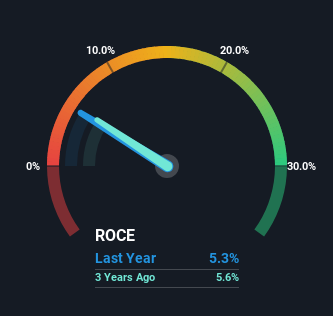- Japan
- /
- Personal Products
- /
- TSE:4922
KOSÉ's (TSE:4922) Returns On Capital Not Reflecting Well On The Business

Finding a business that has the potential to grow substantially is not easy, but it is possible if we look at a few key financial metrics. Amongst other things, we'll want to see two things; firstly, a growing return on capital employed (ROCE) and secondly, an expansion in the company's amount of capital employed. This shows us that it's a compounding machine, able to continually reinvest its earnings back into the business and generate higher returns. In light of that, when we looked at KOSÉ (TSE:4922) and its ROCE trend, we weren't exactly thrilled.
Understanding Return On Capital Employed (ROCE)
For those who don't know, ROCE is a measure of a company's yearly pre-tax profit (its return), relative to the capital employed in the business. To calculate this metric for KOSÉ, this is the formula:
Return on Capital Employed = Earnings Before Interest and Tax (EBIT) ÷ (Total Assets - Current Liabilities)
0.053 = JP¥16b ÷ (JP¥372b - JP¥70b) (Based on the trailing twelve months to December 2023).
Therefore, KOSÉ has an ROCE of 5.3%. Ultimately, that's a low return and it under-performs the Personal Products industry average of 10%.
Check out our latest analysis for KOSÉ

In the above chart we have measured KOSÉ's prior ROCE against its prior performance, but the future is arguably more important. If you'd like to see what analysts are forecasting going forward, you should check out our free analyst report for KOSÉ .
What Can We Tell From KOSÉ's ROCE Trend?
On the surface, the trend of ROCE at KOSÉ doesn't inspire confidence. Around five years ago the returns on capital were 24%, but since then they've fallen to 5.3%. However it looks like KOSÉ might be reinvesting for long term growth because while capital employed has increased, the company's sales haven't changed much in the last 12 months. It may take some time before the company starts to see any change in earnings from these investments.
In Conclusion...
Bringing it all together, while we're somewhat encouraged by KOSÉ's reinvestment in its own business, we're aware that returns are shrinking. Since the stock has declined 53% over the last five years, investors may not be too optimistic on this trend improving either. Therefore based on the analysis done in this article, we don't think KOSÉ has the makings of a multi-bagger.
On a final note, we've found 3 warning signs for KOSÉ that we think you should be aware of.
While KOSÉ isn't earning the highest return, check out this free list of companies that are earning high returns on equity with solid balance sheets.
Valuation is complex, but we're here to simplify it.
Discover if KOSÉ might be undervalued or overvalued with our detailed analysis, featuring fair value estimates, potential risks, dividends, insider trades, and its financial condition.
Access Free AnalysisHave feedback on this article? Concerned about the content? Get in touch with us directly. Alternatively, email editorial-team (at) simplywallst.com.
This article by Simply Wall St is general in nature. We provide commentary based on historical data and analyst forecasts only using an unbiased methodology and our articles are not intended to be financial advice. It does not constitute a recommendation to buy or sell any stock, and does not take account of your objectives, or your financial situation. We aim to bring you long-term focused analysis driven by fundamental data. Note that our analysis may not factor in the latest price-sensitive company announcements or qualitative material. Simply Wall St has no position in any stocks mentioned.
About TSE:4922
KOSÉ
Manufactures and sells cosmetics and cosmetology products primarily in Japan and internationally.
Flawless balance sheet with moderate growth potential.
Similar Companies
Market Insights
Community Narratives



